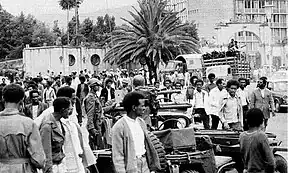Ethiopian Revolution
The Ethiopian Revolution (Amharic: የኢትዮጵያ አብዮት; 12 January – 12 September 1974) was a period of civil, police and military upheaval in Ethiopia to protest against the weakened Haile Selassie government. It is generally thought to have begun on 12 January 1974 when Ethiopian soldiers began a rebellion in Negele Borana, with the protests continuing into February 1974. People from different occupations, starting from junior army officers, students and teachers, and taxi drivers, joined a strike to demand human rights, social change, agrarian reforms, price controls, free schooling, and releasing political prisoners, and labor unions demanded a fixation of wages in accordance with price indexes, as well as pensions for workers, etc.
| Ethiopian Revolution | |
|---|---|
| Part of Opposition to Haile Selassie | |
Clockwise from top: The Coordinating Committee of the Armed Forces (Derg); the 1974 coup d'état of Haile Selassie; Public demonstration on 24 August 1974 | |
| Date | 12 January – 12 September 1974 (8 months) |
| Location | |
| Caused by |
|
| Goals | Human rights, social change, agrarian and land reforms, price controls, free schooling, releasing political prisoners |
| Methods | |
| Resulted in |
|
In June 1974, a group of army officers established the Coordinating Committee of the Armed Forces, later branding itself as the Derg, which struggled to topple Haile Selassie's cabinet under Prime Minister Endelkachew Makonnen. By September of that year, the Derg began detaining Endalkachew's closest advisors, dissolved the Crown Council and Imperial Court and disbanded the emperor's military staff. The Ethiopian Revolution ended with the 12 September coup d'état of Haile Selassie by the Coordinating Committee.
Background
For many centuries, the Ethiopian Empire had a semi-feudal mode of production, with most land held by the church (25%), the Emperor (20%), the feudal lords (30%) and the state (18%), leaving a mere 7% to the roughly 23 million Ethiopian peasants. The landless peasants lost as much as 75% of their produce to the landlords, leaving them in a miserable life state. Haile Selassie had also promised to reform and modernize the country.[1]
The late 1960s in Ethiopia included student movements developing their knowledge of and debating the social sciences and social change. Their debates were influential in their opposition to Emperor Haile Selassie.[2] In December 1960, a coup d'état attempt seeking liberal reforms, including land reforms and land redistribution, took place. The Wollo and Tigray famines, ongoing since 1958, overshadowed the emperor's reputation, affecting the peasants.[3] The government negligence in dealing with the famine was known by this point, and no relief effort report arrived via the Ministry of the Interior in November 1965 for 1965/6 famine in Were Illu, taking 302 days to reach the emperor.[1]
Events
The Ethiopian Revolution is widely considered to have begun on 12 January 1974 when a group of Ethiopian soldiers rebelled in Negele Borana.[4] In February 1974 the military rulers of the Ethiopian Army, who were not ideologically united, comprised conservatives, moderates and radicals. In the process of socialist reforms, the radicals emerged victorious and wrested state power.[5]
The Coordinating Committee of the Armed Forces formed in June 1974, later called the Derg, which decided to seize power from the emperor while confronting the Prime Minister, Endelkachew Makonnen.[6] Endelkachew was criticized for his backwardness in reforms which the Emperor, as the constitutional head, agreed to. On the Coordinating Committee's recommendation, Haile Selassie appointed him Chief of Staff of the Armed Forces in early July 1974.[6][7]
Analysis
Elleni Zeleke argues that 1960s' student movements' views on social sciences and social change were major factors in not only the 1974 revolution itself, but also in socially progressive and lethally repressive aspects of the revolution, and in the later Fall of the Derg and events during the rule of the Ethiopian People's Revolutionary Democratic Front.[2]
References
- Gupta, Vijay (April 1978). "The Ethiopian Revolution: Causes and Results". India Quarterly: A Journal of International Affairs. 34 (2): 158–174. doi:10.1177/097492847803400203. ISSN 0974-9284. S2CID 150699038.
- Elleni Zeleke (2019). Ethiopia in Theory: Revolution and Knowledge Production, 1964–2016. Brill Publishers. ISBN 978-90-04-41475-4. Wikidata Q117768677.
- Love, Robert S. (1979). "Economic Change in Pre-Revolutionary Ethiopia". African Affairs. 78 (312): 339–355. doi:10.1093/oxfordjournals.afraf.a097109. ISSN 0001-9909. JSTOR 722145.
- Bellucci, Stefano (18 September 2022). "The 1974 Ethiopian Revolution at 40: Social, Economic, and Political Legacies". Northeast African Studies. 16 (1): 1–13. doi:10.14321/nortafristud.16.1.0001. S2CID 148384238.
- Gupta, Vijay (1978). "The Ethiopian Revolution: Causes and Results". India Quarterly. 34 (2): 158–174. doi:10.1177/097492847803400203. ISSN 0974-9284. JSTOR 45071379. S2CID 150699038.
- "THE ETHIOPIAN REVOLUTION" (PDF). 18 September 2022.
- NA, NA (2016-09-27). Layers of Time: A History of Ethiopia. Springer. ISBN 978-1-137-11786-1.
- "Ethiopian Premier Orders Former Officials Detained". The New York Times. 1974-04-19. ISSN 0362-4331. Retrieved 2022-09-18.
- Kane, Thomas L. (1991). "Excerpts from the Prison Diary of Ahadu Saboure". Northeast African Studies. 13 (1): 59–71. ISSN 0740-9133. JSTOR 43660337.
- Gebeyehu, Temesgen (2010). "The Genesis and Evolution of the Ethiopian Revolution and the Derg: A Note on Publications by Participant in Events". History in Africa. 37: 321–327. doi:10.1353/hia.2010.0035. ISSN 0361-5413. JSTOR 40864628. S2CID 144500147.
- "Imprisonment and Death". thehaileselassie.com. Retrieved 2022-09-18.
_in_1974.jpg.webp)

